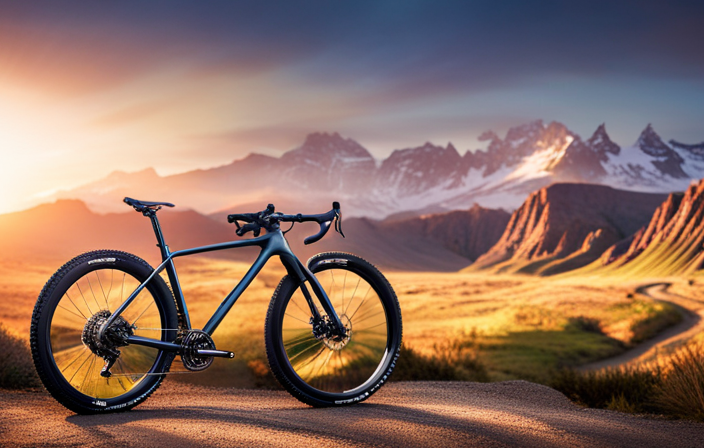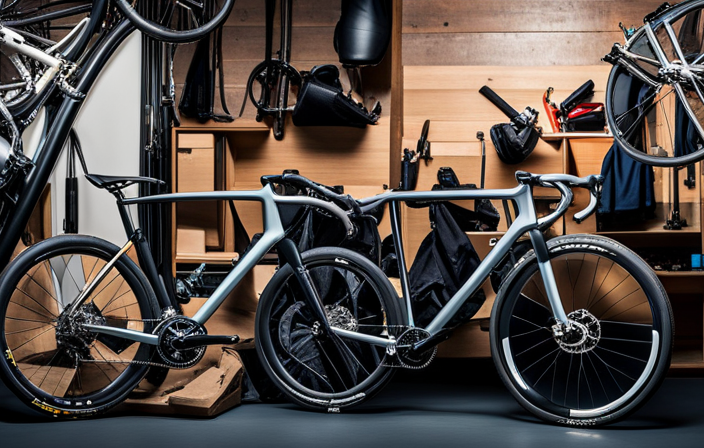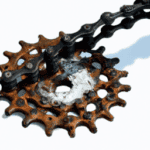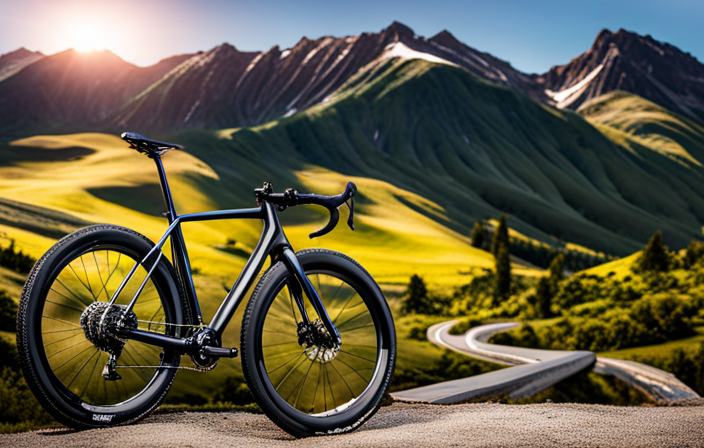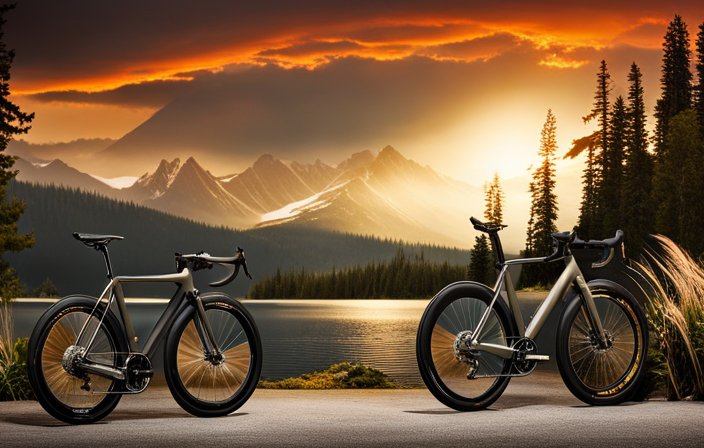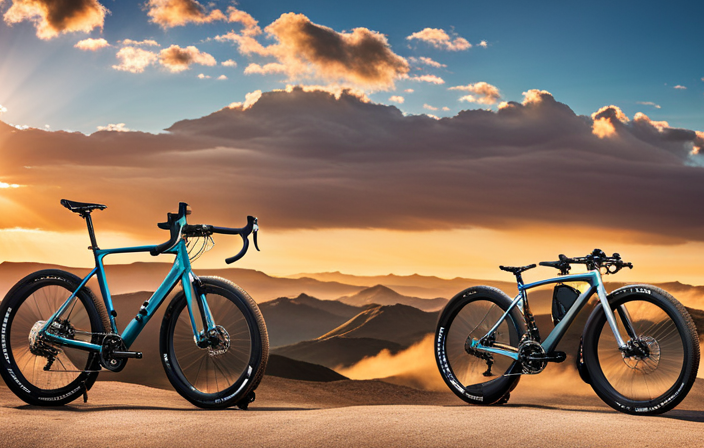Attention gravel bike owners! It is crucial to prioritize proper maintenance in order to uphold the performance and lifespan of your reliable two-wheeler.
But how frequently should you clean your gravel bike? Fear not, for I am here to shed light on this crucial question.
In this comprehensive guide, we will delve into the importance of regular cleaning, factors that determine cleaning frequency, and provide step-by-step instructions along with expert tips for keeping every component pristine.
So grab a cuppa and let’s embark on a journey to maintain your gravel bike like a pro!
Key Takeaways
- Regular cleaning is important for maintaining bike performance and longevity.
- The frequency of cleaning depends on factors such as riding conditions, weather, and frequency of use.
- Neglecting cleaning can lead to damage and decreased performance.
- Cleaning specific bike parts, such as wheels, chains, and drivetrain, is essential for optimal performance and longevity.
Importance of Regular Cleaning for Bike Maintenance
You should make sure to clean your gravel bike regularly to maintain its performance and longevity. The importance of regular cleaning for bike longevity cannot be overstated.
Riding on gravel roads exposes your bike to various elements like dust, dirt, mud, and even small rocks that can accumulate in the nooks and crannies of your bike. If left unattended, these particles can cause wear and tear on important components such as the drivetrain, bearings, and brakes. Regular cleaning helps remove these contaminants and prevents them from causing damage.
Using specific cleaning products designed for bikes offers several benefits. These products are formulated to effectively break down dirt and grime without harming delicate parts of your bike. They also help protect against rust and corrosion by leaving a protective coating on the metal surfaces. Additionally, some cleaning products have degreasing properties that can effectively remove built-up grease from the drivetrain, ensuring smooth shifting.
Transitioning into factors that determine cleaning frequency: It is essential to consider several factors when determining how frequently you should clean your gravel bike.
Factors that Determine Cleaning Frequency
When determining how frequently to clean my gravel bike, there are three key factors that I consider.
Firstly, riding conditions play a significant role in the amount of dirt and debris that accumulates on my bike. If I’m riding on muddy or dusty trails, I’ll need to clean my bike more often.
Secondly, weather conditions like rain or snow can also impact cleaning frequency. These elements can cause rust or damage to certain parts of the bike, so it’s important to clean it more regularly in these conditions.
Lastly, the frequency of use also determines how often my gravel bike needs to be cleaned. The more I ride it, the more maintenance it will require to keep it running smoothly.
Overall, these factors all contribute to how frequently I clean my gravel bike. It’s important to consider each one to ensure that my bike stays in optimal condition.
Riding Conditions
For optimal maintenance, it’s important to consider the riding conditions and how frequently you should clean your gravel bike. Riding techniques and gravel bike accessories can greatly impact the amount of dirt and grime that accumulates on your bike.
Riding techniques such as cornering aggressively or riding through muddy terrain can result in a higher accumulation of dirt and debris on your bike. Using certain accessories like fenders or mudguards can help minimize the amount of dirt that splashes onto your bike. Wet conditions, including rain or wet roads, can also lead to more dirt buildup.
Regularly cleaning your gravel bike is essential to prevent damage to its components and ensure smooth operation. Neglecting regular cleaning can lead to increased wear and tear on the drivetrain, decreased braking performance, and potential damage to sensitive parts.
In the next section about weather conditions, we will explore how different weather factors affect cleaning frequency without writing ‘step’.
Weather Conditions
Considering the weather conditions can impact how often you need to maintain your gravel bike. The frequency at which you clean your bike depends on the weather conditions you ride in.
If you frequently ride in wet and muddy conditions, then you will need to clean your gravel bike more often. Wet and muddy rides can cause dirt, grime, and debris to build up on your bike, affecting its performance and longevity. It is recommended to clean your bike after every wet or muddy ride to prevent any damage or corrosion.
However, if you mostly ride in dry conditions, cleaning your gravel bike once a week should be sufficient. Maintaining a regular cleaning schedule will ensure that your bike stays in optimal condition for longer periods of time.
Moving on to the next section about frequency of use…
Frequency of Use
The more often you ride your gravel bike, the more maintenance it will require. Regular cleaning is essential to keep your bike in optimal condition and ensure a smooth and enjoyable riding experience. Here are four reasons why regular maintenance is important:
-
Preventive care: Cleaning your gravel bike regularly can help identify any potential issues before they become major problems.
-
Improved performance: Regular cleaning removes dirt, mud, and debris that can accumulate on your bike, allowing it to perform at its best.
-
Prolonged lifespan: By keeping your gravel bike clean and well-maintained, you can extend its overall lifespan and avoid costly repairs or replacements.
-
Safety first: A clean bike reduces the risk of accidents caused by malfunctioning parts or compromised performance.
By understanding the importance of cleaning frequency and the benefits of regular maintenance, you can ensure that your gravel bike remains in top shape for all your adventures on the road or trail.
In the following section about basic cleaning steps for gravel bikes…
Basic Cleaning Steps for Gravel Bikes
To clean your gravel bike, start by removing any excess dirt or debris. Use a soft brush to gently scrub the frame, handlebars, and other components. Pay close attention to hard-to-reach areas like the fork crown or bottom bracket. For cleaning products, I recommend using a mild soap or bike-specific cleaner diluted in water. Avoid harsh chemicals that can damage the paint or components of your bike.
When it comes to cleaning techniques, take care not to use excessive force as it may scratch or damage the surface of your bike. Instead, apply gentle pressure and circular motions to remove stubborn dirt or grime. Rinse off any residue with clean water and dry your bike thoroughly with a clean cloth.
Here’s a helpful table summarizing the basic steps for cleaning your gravel bike:
| Step | Action |
|---|---|
| 1 | Remove excess dirt and debris |
| 2 | Gently scrub with a soft brush |
| 3 | Use mild soap or bike-specific cleaner diluted in water |
| 4 | Rinse with clean water and dry thoroughly |
By following these steps, you’ll keep your gravel bike looking its best and ensure optimal performance on your next ride. Now let’s move on to discuss the essential cleaning tools and products for maintaining your gravel bike without compromising its integrity.
Cleaning Tools and Products for Gravel Bikes
For optimal maintenance of your gravel bike, it’s important to have the right cleaning tools and products. Here are three essential items you’ll need to keep your bike in top shape:
-
Brushes: Invest in a set of brushes specifically designed for bike cleaning. Look for a soft-bristle brush to gently remove dirt and grime from the frame and components, as well as a smaller brush for hard-to-reach areas like chainrings and cassettes.
-
Degreaser: A good degreaser is crucial for removing stubborn grease and oil buildup on your drivetrain. Choose a biodegradable option that is safe for both metal surfaces and the environment.
-
Bike-specific cleaner: Using a dedicated bike cleaner will help break down dirt without damaging the paint or finish of your frame. Look for one that is specifically formulated for gravel bikes and suitable for all types of surfaces.
When it comes to cleaning techniques, start by rinsing off any loose dirt with water before applying the bike cleaner. Use the brushes to scrub away grime, paying attention to hard-to-reach areas like sprockets and derailleurs. Rinse thoroughly with clean water after cleaning.
Now that you have the right tools and products, let’s delve into some tips and techniques for effectively cleaning different parts of your gravel bike…
Cleaning Tips and Techniques for Different Bike Parts
Start by removing the wheels from your gravel bike for easier access to clean different parts. Cleaning your bike wheels is an essential part of maintaining your gravel bike. To clean the wheels, start by using a soft brush or sponge and warm soapy water to remove any dirt or grime. Pay close attention to the spokes and rims, as these areas can accumulate a lot of debris. Rinse thoroughly with clean water and dry with a cloth or air compressor.
When it comes to cleaning and maintaining bike chains, there are a few tips that can help prolong their lifespan. First, use a degreaser specifically designed for bike chains to remove any built-up grease or dirt. Apply the degreaser onto the chain and use a brush or rag to scrub away the grime. Rinse off with water and dry thoroughly before applying lubricant.
Transitioning into the next section about cleaning and maintaining tubeless tires, it’s important to note that regular cleaning is crucial for keeping them in optimal condition.
Cleaning and Maintaining Tubeless Tires
Make sure you regularly check and maintain your tubeless tires to keep them in good condition. Tubeless tire installation is a crucial step in ensuring a smooth and hassle-free ride. When installing tubeless tires, it’s important to follow the manufacturer’s instructions carefully. This includes cleaning the rim bed thoroughly, applying a layer of tape, and seating the tire properly. A well-installed tubeless tire provides better traction, reduced rolling resistance, and increased puncture resistance compared to traditional clincher tires.
Once your tubeless tires are installed, it’s essential to regularly inspect and maintain the sealant. Tubeless tire sealant is responsible for sealing small punctures on-the-go, preventing air leakage. To ensure optimal performance, check the sealant levels every few months or after encountering rough terrain that may cause punctures. If necessary, add more sealant as per the manufacturer’s recommendations.
In addition to checking sealant levels periodically, it’s also crucial to clean out any dried or clogged sealant from the valve stem and core. This will help prevent blockages that can hinder proper inflation or deflation of your tubeless tires.
Keeping your tubeless tires in good condition ensures a safe and enjoyable ride. Now let’s move on to cleaning and lubricating the chain for optimal bike performance.
Cleaning and Lubricating the Chain
Regularly cleaning and lubricating the chain is essential for maintaining optimal bike performance. The chain is a crucial component of the drivetrain, responsible for transferring power from your legs to the wheels. Over time, dirt, grit, and grime can accumulate on the chain, causing it to become less efficient and wear out faster. By regularly cleaning and lubricating the chain, you can extend its lifespan and ensure smooth shifting.
To start, I recommend using a degreaser to remove any built-up grease and dirt from the chain. Apply the degreaser generously and use a brush or rag to scrub away debris. Once clean, thoroughly rinse the chain with water and dry it completely before moving on to the next step.
After cleaning, it’s important to apply lubricant to keep the chain running smoothly. Choose a high-quality bicycle-specific lubricant that suits your riding conditions (dry or wet). Apply a small amount of lubricant onto each link of the chain while rotating the pedals backward. This will help distribute the lubricant evenly.
Remember not to over-lubricate as excess oil can attract more dirt. After applying lubricant, wipe off any excess with a clean rag.
By regularly cleaning and lubricating your bike’s chain, you’ll enjoy smoother shifting, increased efficiency, and prolonged life for both your drivetrain components and your overall biking experience.
Moving on to cleaning and maintaining the drivetrain…
Cleaning and Maintaining the Drivetrain
After properly cleaning and lubricating the chain, it’s important to also pay attention to other components of the drivetrain to ensure optimal performance of your gravel bike. This includes cleaning and maintaining the pedals and derailleur.
To clean the pedals, start by removing them from the bike using a pedal wrench. Use a brush or cloth soaked in mild soapy water to scrub away any dirt or grime on the pedals. Pay special attention to the areas around the cleats for clipless pedals. Once clean, dry them thoroughly before reinstalling.
Next, let’s move on to cleaning and lubricating the derailleur. This is an essential part of keeping your drivetrain running smoothly. Begin by using a degreaser spray or solvent to remove any built-up grease or debris from the derailleur mechanism. Then, use a brush or cloth to scrub away any remaining dirt. After cleaning, apply a few drops of lubricant onto each pivot point and moving part of the derailleur.
By regularly cleaning and maintaining both your pedals and derailleur, you can ensure that they function properly and extend their lifespan. Now that we’ve covered this step, let’s move on to discussing how to clean and protect the frame and components…
Cleaning and Protecting the Frame and Components
To ensure the longevity and performance of your frame and components, it’s important to properly clean and protect them. One essential aspect of this is protecting the frame from rust.
Gravel bikes are often exposed to various weather conditions and terrains, making them prone to corrosion. To prevent rust, start by thoroughly cleaning the frame using a mild bike-specific detergent and a soft brush or sponge. Pay special attention to hard-to-reach areas like joints and welds, as dirt and moisture tend to accumulate there. After cleaning, make sure to dry the frame completely with a clean towel or air compressor.
Once the frame is dry, it’s crucial to apply a protective coating such as wax or silicone spray. This creates a barrier against moisture and contaminants that can lead to rust formation. Apply the protective coating evenly on all surfaces of the frame, including inside tubes if possible.
In addition to protecting the frame itself, don’t forget about other components like bolts, cables, and derailleurs. These areas are also susceptible to rust and should be cleaned regularly with a degreaser followed by lubrication.
By taking these steps to clean and protect your gravel bike’s frame and components, you’ll not only extend their lifespan but also maintain optimal performance in any riding condition.
Moving on to maintaining disc brakes…
Cleaning and Maintaining Disc Brakes
When it comes to cleaning and maintaining disc brakes on my gravel bike, there are two key points that I always pay attention to.
Firstly, I make sure to clean the brake rotors regularly using a non-corrosive cleaner and a soft cloth. This helps to remove any dirt, grime, or oil that may have accumulated on the rotors, which can affect braking performance.
Secondly, I regularly inspect the brake pads for wear and adjust them as necessary. This is important because worn brake pads can reduce braking power and make it harder to stop effectively. By checking the brake pads regularly, I can ensure that they are in good condition and replace them if needed.
By staying on top of these maintenance tasks, I can ensure that my disc brakes perform at their best every time I hit the trails.
Cleaning the Brake Rotors
Make sure you clean the brake rotors regularly to maintain optimal performance. Cleaning the brake rotors is an essential part of maintaining your disc brakes and ensuring they function properly. There are various cleaning techniques you can use to remove brake dust and other debris from the rotors.
One method is to use a clean cloth or paper towel soaked in rubbing alcohol or brake cleaner to wipe down the rotor surface. Gently scrubbing with a soft-bristled brush can also help remove stubborn dirt and grime. It’s important to be thorough when cleaning the rotors, making sure to get into all the crevices and corners.
By keeping your brake rotors clean, you can prevent buildup that could affect braking efficiency and safety. After cleaning the rotors, it’s time to move on to checking and adjusting brake pad wear, which ensures proper contact between the pads and rotors for optimal braking performance.
Checking and Adjusting Brake Pad Wear
Checking and adjusting brake pad wear is crucial for maintaining optimal braking performance. It’s important to regularly inspect your brake pads to ensure they are aligned properly and have sufficient thickness. Misaligned or worn brake pads can result in decreased stopping power and potential safety hazards.
To check the alignment, visually inspect the position of the pads on both sides of the rotor. If there is any asymmetry, adjust them accordingly using the appropriate tools. Additionally, measure the thickness of the brake pads using a caliper. If they have worn down beyond their recommended limit, it’s time for a replacement.
By staying vigilant with these maintenance tasks, you can ensure that your gravel bike will always provide reliable braking power when you need it most.
Now let’s transition into cleaning and lubricating moving parts and bearings to further optimize your gravel bike’s performance.
Cleaning and Lubricating Moving Parts and Bearings
To keep your gravel bike running smoothly, it is essential to regularly clean and lubricate its moving parts and bearings. This will ensure optimal performance and extend the lifespan of your bike.
One crucial area to focus on is the chainring and cassette. These components are prone to dirt and grime buildup, which can lead to poor shifting and decreased efficiency. To clean them, start by removing the chain using a chain tool, then use a degreaser and a brush to remove any accumulated debris. Once clean, apply a lubricant specifically designed for bicycle chains to ensure smooth operation.
Another vital part of your bike that requires attention is the bottom bracket. It is responsible for connecting the crankset with the frame’s shell and allows for smooth rotation of the cranks. Cleaning this area involves removing any dirt or grit that may have accumulated around it using a brush or rag dampened with water or mild detergent. After cleaning, apply grease or an appropriate lubricant to maintain smoothness.
Now that you have cleaned and lubricated your gravel bike’s moving parts and bearings, let’s move on to cleaning and maintaining suspension components without compromising their functionality.
Cleaning and Maintaining Suspension Components
After thoroughly cleaning and lubricating the moving parts and bearings of my gravel bike, I turn my attention to another important aspect of maintenance – cleaning and maintaining the suspension components.
Suspension forks play a vital role in ensuring a smooth and comfortable ride on rough terrains, so it’s crucial to keep them clean and in good working condition.
To clean suspension forks, I start by wiping off any dirt or debris from the stanchions using a soft cloth. It’s essential not to use any harsh chemicals or abrasive materials that could damage the delicate seals or coatings.
Next, I use a suspension-specific cleaner to remove any stubborn grime or residue. Carefully spraying the cleaner onto the stanchions and other exposed areas, I then wipe it away with a clean cloth.
Once the forks are clean, it’s important to inspect them for any signs of damage or wear. This includes checking for oil leaks, loose bolts, or worn-out bushings. If there are any issues, it’s best to consult a professional bike mechanic for further evaluation and repair.
With my suspension forks cleaned and inspected, I can now move on to the next step: cleaning and storing the bike during off-seasons.
Cleaning and Storing the Bike During Off-Seasons
During the off-season, it’s important to clean and store your bike properly to ensure its longevity.
Winter cleaning involves removing dirt, salt, and grime that may have accumulated on the bike during cold weather rides.
Long-term storage tips include keeping the bike in a dry and cool place, lubricating all moving parts, and protecting it from dust and moisture with a cover or bag.
Winter Cleaning and Storage
For winter cleaning and storage, it’s important to properly clean and store your gravel bike.
Winter riding can be tough on your bike, with dirt, mud, and salt posing a threat to its components.
Start by thoroughly washing your bike using a gentle detergent and warm water. Pay special attention to the drivetrain, as it tends to accumulate the most grime.
Once clean, dry the bike completely before applying lubrication to protect against rust.
It’s also wise to inspect your winter gear, such as fenders or lights, for any damage or wear that may need repair or replacement.
When storing your gravel bike for the winter season, find a cool and dry location where it won’t be exposed to extreme temperatures or moisture. This will ensure its longevity until you’re ready to hit the road again in springtime.
Now let’s move on to long-term storage tips without missing a beat.
Long-Term Storage Tips
To ensure the longevity of your gravel bike during long-term storage, it’s important to follow these tips:
-
Clean and dry the bike thoroughly before storing it. This will prevent dirt and moisture from causing rust on bike components.
-
Apply a protective layer of lubricant on all metal parts to further prevent rust and corrosion. Make sure to cover the chain, gears, and any other exposed metal surfaces.
-
Store your bike in a cool, dry place away from direct sunlight. Extreme temperatures can damage certain materials and affect the overall performance of your bike.
Proper long-term storage for road bikes is crucial in maintaining their condition and preventing rust on bike components. By following these tips, you can ensure that your gravel bike stays in excellent shape even during extended periods of non-use.
Now let’s move on to discussing the regular maintenance schedule for gravel bikes.
Regular Maintenance Schedule for Gravel Bikes
When it comes to maintaining my gravel bike, I have developed a daily cleaning and maintenance routine that ensures its optimal performance. This routine includes tasks such as wiping down the frame, lubing the chain, and checking tire pressure.
Additionally, I make sure to perform weekly and monthly maintenance tasks like checking brake pads and derailleurs for wear, as well as inspecting the wheels for any signs of damage.
Lastly, I prioritize a yearly tune-up and service where I take my bike to a professional for a comprehensive check-up and any necessary repairs or adjustments.
Daily Cleaning and Maintenance Routine
Make sure you incorporate a daily cleaning and maintenance routine for your gravel bike. This will help keep your bike in optimal condition and extend its lifespan.
To effectively clean your bike on a daily basis, there are a few essential cleaning tools you should have on hand:
- Soft bristle brush: Use this to gently scrub away dirt and debris from the frame, wheels, and drivetrain.
- Bike-specific degreaser: Apply this to the chain, cassette, and derailleurs to remove built-up grime.
- Microfiber cloth: Use this to wipe down the frame and components after cleaning.
Additionally, it’s important to check the tire pressure, inspect brake pads for wear, and lubricate the chain regularly. By incorporating these daily tasks into your routine, you’ll ensure that your gravel bike is always ready for your next adventure.
Moving forward into weekly and monthly maintenance tasks…
Weekly and Monthly Maintenance Tasks
Incorporate weekly and monthly maintenance tasks into your routine to keep your gravel bike in top condition. Regular cleaning is crucial for bike maintenance as it helps prevent dirt, grime, and debris from building up and causing damage to the components.
The frequency of cleaning will depend on various factors such as riding conditions, weather, and personal preference. If you frequently ride in muddy or wet conditions, you may need to clean your bike more often. A general rule of thumb is to clean your gravel bike at least once a week and perform a more thorough monthly cleaning.
This includes washing the frame, drivetrain, wheels, and brakes, as well as checking for any signs of wear or damage. By regularly maintaining and cleaning your gravel bike, you can ensure optimal performance and prolong its lifespan.
Moving on to the next section about yearly tune-up and service…
Yearly Tune-Up and Service
To keep your gravel bike in top condition, it’s important to schedule a yearly tune-up and service. This ensures that all the components are working properly and extends the lifespan of your bike.
During a yearly tune-up, a professional mechanic will inspect and adjust the gears, brakes, and wheels to ensure they are functioning optimally. They will also check for any signs of wear or damage that may need repair or replacement.
Here are five reasons why a yearly tune-up is essential:
- It improves performance and efficiency.
- It prevents costly repairs down the line.
- It maintains safety by ensuring all components are in good working order.
- It extends the life of your bike.
- It enhances your riding experience.
With regular yearly tune-ups and servicing, you can enjoy many more miles on your gravel bike.
Now let’s move on to some final thoughts on cleaning your gravel bike…
Final Thoughts on Cleaning Your Gravel Bike
In conclusion, it’s important to regularly clean your gravel bike for optimal performance and longevity. By maintaining a consistent cleaning schedule, you can ensure that your bike is always ready for the next adventure on the gravel roads.
Cleaning frequency benefits your bike in several ways. Firstly, it helps prevent dirt and grime from building up on crucial components such as the drivetrain and brakes, which can cause premature wear and tear. Secondly, regular cleaning allows you to inspect your bike for any potential issues or damage that may have occurred during your rides. This proactive approach can help identify problems early on and prevent them from becoming bigger headaches down the road.
To achieve the best cleaning practices, start by giving your bike a thorough rinse with water to remove any loose debris. Then, use a gentle soap or specialized bike cleaner to scrub away stubborn dirt and grease. Pay close attention to areas prone to buildup like the chainrings, cassette, and derailleur pulleys. Afterward, rinse off all soap residue and dry your bike thoroughly before applying lubrication to the chain and other moving parts.
Remember that different riding conditions may require more frequent cleaning sessions. If you frequently ride in muddy or wet environments, consider increasing the frequency of your cleanings to maintain optimal performance.
By following these recommended cleaning practices and staying consistent with maintenance routines, you’ll keep your gravel bike running smoothly for years to come. Don’t neglect this essential aspect of caring for your trusty steed!
Frequently Asked Questions
Can I use regular household cleaning products to clean my gravel bike?
Yes, you can use regular household cleaning products to clean your gravel bike. However, there are benefits to using specific cleaning products designed for bikes.
These products are formulated to remove dirt, grime and grease without damaging the bike’s components. They also help to protect the frame and other parts from corrosion.
Using specialized cleaning products ensures a thorough and effective clean, prolonging the lifespan of your gravel bike and maintaining its performance.
How often should I clean the saddle and handlebars of my gravel bike?
I recommend cleaning the saddle and handlebars of your gravel bike regularly to maintain their appearance and functionality.
Using appropriate cleaning products for gravel bikes, such as gentle bike-specific cleaners, will help remove dirt and grime without causing damage.
Start by wiping them down with a damp cloth or sponge, then apply the cleaner and scrub gently if necessary.
Finish by drying them thoroughly to prevent any moisture-related issues.
Remember, proper maintenance is essential for a long-lasting and enjoyable riding experience.
Are there any specific cleaning techniques for cleaning the cassette and derailleur?
When it comes to cleaning the cassette and derailleur of your gravel bike, there are a few specific techniques you should follow.
Start by removing the chain and pedals for easier access.
Use a degreaser and a brush to thoroughly clean the cassette teeth, ensuring all dirt and grime is removed.
For the derailleur, pay special attention to its hanger, as keeping it clean is crucial for smooth shifting.
Regularly cleaning these components will help maintain their performance and extend their lifespan.
What is the best way to clean and maintain the tubeless tire sealant?
To maintain tubeless tire sealant effectively, it’s crucial to use the best sealant brands available in the market. My top picks include Stan’s NoTubes and Orange Seal.
Regularly inspecting your tires for any punctures or leaks is essential. If you encounter common sealant issues like drying out or clogging, try shaking the bottle vigorously before adding more sealant.
Additionally, ensure you clean and remove old sealant residue from your tires to maximize its performance and longevity.
Are there any special cleaning considerations for carbon fiber frames?
When it comes to cleaning carbon fiber frames, there are a few important considerations.
First, avoid using harsh chemicals or abrasive materials that could damage the delicate finish. Instead, opt for a mild soap and water solution and a soft cloth or sponge.
Pay extra attention to areas with dirt buildup, such as the bottom bracket and fork crown.
Regularly inspect your frame for any signs of damage or cracks, and address them promptly.
These cleaning tips will help maintain the integrity and appearance of your carbon fiber frame for years to come.
For more maintenance tips, keep reading!
Conclusion
In conclusion, maintaining a clean gravel bike is crucial for its longevity and performance. Just like our own bodies, bikes need regular care to function at their best.
By adhering to a consistent cleaning schedule and using the right tools and products, you can ensure that your bike stays in top shape. Remember, cleanliness is not just about appearance; it reflects our commitment to taking care of something we value.
So let’s keep those wheels spinning smoothly and enjoy the open road ahead!
